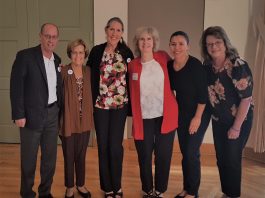New school superintendent will do what is best for the students
The Morgan Hill School District Board of Trustees this week
Separate wheat from chaff in presidential race
Ben Franklin is frequently cited for "In this world nothing is certain but death and taxes." If you have paid any attention to the current presidential race, you will be tempted to add that Republicans will make an a big deal over illegal immigration. They think that immigration will be a strong issue for them.
Is the City Deaf or are the People Not Talking?
Great ideas fail because of poor execution. The City of Morgan
Guest view: Government not the solution to homelessness
I am responding to your guest view by Sen. Bill Monning, Jan. 22. The discussion of homelessness and mental illness has been a perennial discussion. There have been calls for affordable housing, an end to homelessness, and support for mental illness for as long as I can remember. Monning’s guest view is no different.Today we put way too much credit in the opinions, suggestions and programs pushed by politicians. Based on the continuing nature of the problem, the suggestions and work of the politicians and the government has been ineffective. I recall an essay by Bertrand Russell, “An Outline of Intellectual Rubbish.”It is an essay that should be mandatory reading by anyone that is concerned with the operation of government.“As soon as we abandon our reason, and are content to rely on authority, there is no good end to our troubles. Whose authority?” Russell writes.He was referring to people’s practice of relying on scripture. I choose to believe that he would also consider the reliance on the words of a politician, as if they were scripture, as almost the same thing. Mr. Monning is pushing the same old, but repackaged, ideas as solving a problem that has yet to be solved. His conclusions are optimistic at best and unfounded at their worst. They are based on anecdotal evidence and wishful thinking. He ignores criticisms of his ideas. There is not unanimity in the arena of affordable housing, homelessness or mental illness that promotes a one-size-fits-all solution.One-size-fits-all solutions come part and parcel with politicians like Mr. Monning. It gives them access to lots of money handed out by the federal government. It also allows them to pretend that they lead solutions, which supports their reelection.“Politics is largely governed by sententious platitudes which are devoid of truth.” Those words by Russell still ring true today:“The power of governments over men’s beliefs has been very great ever since the rise of large states….But the power of governments over belief in the present day is vastly greater than at any earlier time. A belief, however untrue, is important when it dominates the action of masses of men.”Russell was referring to war, but it could easily reference any effort by government and politicians to influence belief. He laments:“No one can deny, in the face of evidence, that it is easy, given military power to produce a population of fanatical lunatics. It would be equally easy to produce a population of sane and reasonable people, but many governments do not wish to do so, since such people would fail to admire the politicians who are at the head of these governments.“I am persuaded that there is absolutely no limit to the absurdities that can, by government action, come to be generally believed. Give me an adequate army, with power to provide it with more pay and better food than falls to the lot of the average man, and I will undertake within 30 years to make the majority of the population believe that two and two are three, that water freezes when it gets hot and boils when it gets cold, or any other nonsense that might seem to serve the interest of the state.”It should be understood that the essay was written six decades ago. He continues with some additional important observations that you can read for yourself.It is worthy to think of ways to help the homeless and the mentally ill. I choose to reject the ideas that come from politicians or government. Clearly these solutions have proved ineffectual by the persistence of most of the problems. Claims of success are either wishful thinking or out and out lies.The involvement of government has been counter-productive. Government programs do not solve problems because problems are generally complex and defy central planning. Flexible and innovative approaches tried by a host of problem solvers will always outperform top-down government and political solutions.So by all means address the plight of mentally ill and homeless. Just don’t count on government or politicians to do it. So maybe government and politicians should step back and not lead. Rather they should listen to quiet voices that speak and advocate for real solutions.Mike Brusa is a retired Morgan Hill resident and an avid reader of history, politics and economics.
Guest View: Weigh in now on HSR route through Morgan Hill
High Speed Rail is moving ahead much more quickly than anyone anticipated. The decision on the preferred option through or around Morgan Hillis going to be made this fall by the HSR Authority, within the next month and a half.The California HSRA has currently identified four different options.Option 1: The “at grade” option adjacent to the Union Pacific line Monterey Road corridor.It is important to understand that the “at grade” proposal is not what you imagine based on the name.The tracks through Morgan Hill would be located on a berm with a retaining wall on both sides, up to 14 feet tall.That would place a 14 foot wall that divides the community. In areas where there is a concern about additional noise (i.e., adjacent to residential structures or other locations) there could be an additional 12 foot high sound wall.In addition, the wall may be located at up to 102 feet from the existing Union Pacific tracks, eliminating hundreds of homes and businesses on the east side of the UP tracks. If you can imagine a three-story building with no windows, activity, ornamentation, or life extending all the way through the community, from north of Cochrane to south of Tennant Avenue, you can visualize how the potential divide will impact the community.Option 2: The aerial approach adjacent to the Union Pacific line Monterey Road corridor.The aerial approach is a monorail-like structure with two tracks up to 50 feet wide. This would be substantially higher than Option 1, at a minimum of 30 feet and up to 60 feet above the area to the east of the tracks through the city. There may also be a 102-foot setback from the UP lines.This option would impact hundreds of new residential units, existing housing and businesses, and create a huge visual and sound division. Option 3: Along the east side of 101.The focus of option 3 is to shift the entire HSR to the east side of 101. The impact on the homes and businesses on that side is clear, especially considering the HSRA would need to cross the freeway twice, at minimum.Option 4: Along the west side of 101.The most recent option, and the one that seems to make the most sense, calls for an aerial approach that would come down Monterey Highway and then, to the north of Sobrato High School, angle off toward 101. HSR would then parallel 101 through Morgan Hill and, after passing Tennant Avenue, would return to connect again with the UP alignment and continue south to Gilroy. This option disrupts the least number of businesses and residents and co-locates noisy activities, freeway and train.We need to tell the HSRA our preferred option now! If we don’t weigh in, we will be completely disregarded by the HSRA. According to the HSRA timeline, by fall of 2016 (yes that's this year), their intent is to have selected two options to take through the environmental review process.It is important as a community that we immediately come together in a way that clearly identifies our preference. Option 4 may not be perfect, but it avoids channeling the HSR through the main part of town, and clusters like functions together.Use the High Speed Rail Comments form on the city website morganhill.ca.gov/forms.aspx?FID=212 to tell the HSRA your preference for the HSR route through Morgan Hill.Lesley Miles is co-owner of Weston Miles Architects in downtown Morgan Hill.
Guest view: Why I Joined the Women’s March on Washington
On Jan. 21, 2017, I joined what are now estimated to be 800,000 other people at the Women’s March on Washington, D.C. (and an estimated four million fellow marchers around the U.S. and the globe). The results of the Presidential election sunk my hopes for this great country, and inspired personal fear as a woman, a person of Jewish descent, as well as for the many marginalized folks whose rights Donald Trump staked his campaign on overturning.I felt alternating bouts of rage and despair that we elected a president who is on record making abusive and derogatory statements about women, people of color and the disabled, as well as bashing our venerated intelligence agencies, to name just a few. Not to mention he has no prior experience in any political office.At first, I was more nervous than excited—I feared reprisal from Trump supporters; I feared that in this frustrated and angry time, a tightly-wound lone shooter might express his dissent in bullets.Fortunately, that was not the case. If the counter-protesters were there, I never saw them. I was packed densely into the center of the National Mall, near Independence and Fourth Streets, with a direct view of the nation’s Capitol. My friend and I arrived by 8 a.m. Saturday morning, and by 8:30, you could no longer see streets in any direction—just bodies upon bodies carrying clever signs announcing their fears and concerns, many bedecked in the now-iconic pink hats.For five hours I stood and listened to fierce, passionate, committed speakers and artists plead for the rights of women, the disabled, the LGBTQ community, and against a Muslim registry and a wall at the Mexican border. Speakers included Gloria Steinem, Angela Davis, Michael Moore, Ashley Judd, Alicia Keys, Van Jones, California Sen. Kamala Davis, D.C. Mayor Muriel Brown, the mothers of slain black children and so many more activists, politicians and entertainers.Despite this enormous outpouring of energy and effort around the country, people are criticizing the movement. What did you want to say? What purpose did it have? Why can’t you all just shut up and accept things as they are?Last I checked, this country is still a democracy, albeit one that’s under threat. The Trump administration has already made clear it is hostile to media criticism. It has made steps to defund women’s health and climate science, and to repeal healthcare. Protest and demonstration are our Constitutional rights and one of the many ways we can create change.Change comes when we the people put pressure on our leaders to let them know what matters to us. As President Trump’s loss of the popular vote by nearly three million votes reveals, he doesn’t speak for many of us.The Women’s March was a fierce rallying cry as we launch into the beginning of many battles: for women’s bodily autonomy, for civil rights, for a decent world where we take care of our own and stay in good stead with the rest of the world.I’ll be bringing the same fierce energy to my own community in the days to come.Jordan Rosenfeld is a local freelance writer and author of seven books. She can be contacted at [email protected].
Gal Pals Get in Touch with Their Masculine Side
You know, it's occurred to me that there are some interesting differences between men and women. Yes, I know about the obvious ones, but there are other, more subtle dissimilarities that we don't necessarily think about every day.
Morgan Hill FFA: A good program in jeopardy
At Live Oak High School, the Future Farmers of America program
Parents Should Have Zero Tolerance For Underage Drinking
At the risk of beating a dead horse, I have to comment yet again on underage drinking, mostly in response to a column printed earlier this week in a certain paper up north, in which the columnist asked how does one raise responsible drinkers if youth aren't supposed to drink alcohol before the age of 21?
Facts paint true picture of socialized health care
Socialized health care is the only solution to the crisis in the










